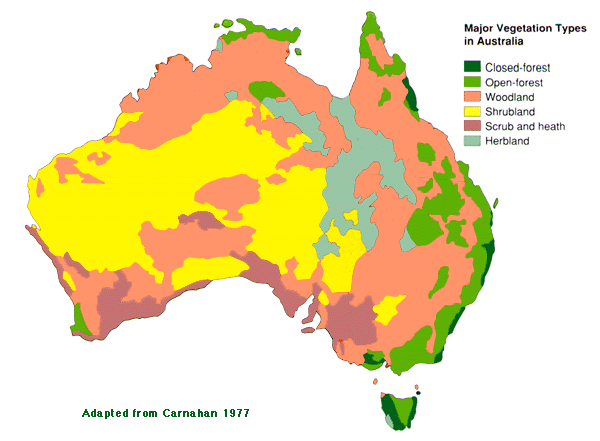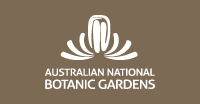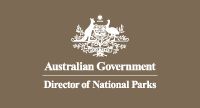A simplified look at Australia's vegetation
There have been various attempts to devise a classification to accommodate the distinctive vegetation of Australia. The system most widely recognised at present was drawn up by Specht (1970) and defines structural forms of vegetation in terms of the dominant plant form and the percentage of foliage cover of the tallest plant layer. The use of foliage cover rather than canopy cover takes special account of the open nature of eucalypt crowns.
In this classification, a tree is defined as a woody plant more than 5 m tall, usually with a single stem. A shrub is a woody plant less than 8 m tall, frequently with many stems arising at or near the base.
The map below gives a simplified representation of the major vegetation types in Australia.

Structural forms of vegetation in Australia (based on Specht 1970)
Percentage foliage cover of tallest plant layer |
||||
| Life form and height of tallest stratum | Dense (70-100%) |
Mid-dense (30-70%) |
Sparse (10-30%) |
Very sparse (<10%) |
| Trees > 30 m | Tall closed-forest | Tall open-forest | Tall woodland | Tall open-woodland |
| Trees 10-30 m | Closed-forest | Open -forest | Woodland | Open-woodland |
| Trees 5-10 m | Low closed-forest | Low open-forest | Low woodland | Low open-woodland |
| Shrubs 2-8 m | Closed -scrub | Open-scrub | Tall shrubland | Tall open-shrubland |
| Shrubs 0-2 m | Closed -heath | Open-heath | Low shrubland | Low open-shrubland |
References:
Carnahan, J.A. in Jeans, D.N. (ed.) (1977), Inside back cover, "Australia: a geography". Sydney University
Press, Sydney.
Specht, R.L. (1970) Vegetation. Pages 44–67 in Leeper, G.W. (ed.), "Australian Environment", 4th edn. Melbourne University Press, Melbourne.
![An Australian Government Initiative [logo]](/images/austgovt_brown_90px.gif)







